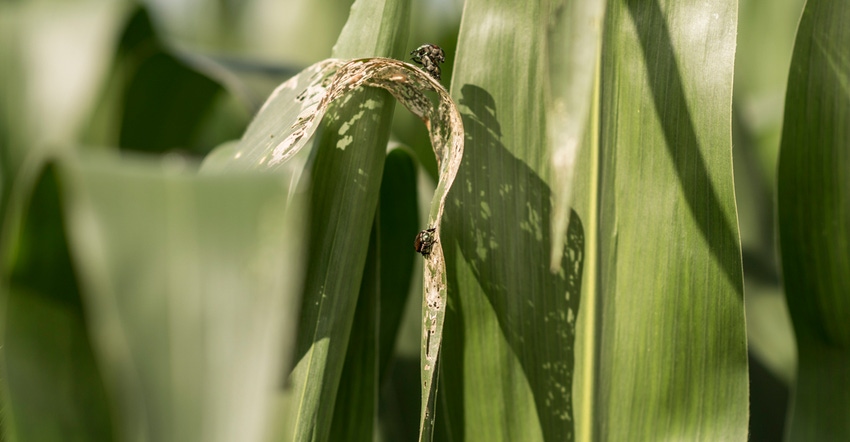September 22, 2020

Understanding this year’s field pressures can help you determine next year’s management strategies.
Here’s a recap of the primary diseases and insects Minnesota farmers faced this year and tips on how to help lower the potential for reoccurrence in 2021.
Corn diseases: Goss’s wilt. The disease that affected the most acres — but still a small percentage of the total corn acres in Minnesota — was Goss’s wilt. It’s often found in irrigated fields where the constant wetness of leaves and the breaking open of leaf cuticles by equipment allows the disease to grow. Northern corn leaf blight was also reported, but again was a minor problem. For the last two years, tar spot has been found in an extremely isolated geography in the far southeastern portion of the state.
If you have a history of Goss’s wilt, ensure you don’t plant the same hybrid again in that field. Instead, choose a hybrid with a high tolerance to Goss’s wilt or rotate the field to soybeans, alfalfa or another suitable crop. Be sure to apply a fungicide on hybrids with a high response to fungicide to help control disease and promote plant health.
Soybean diseases: soybean white mold and sudden death syndrome. The primary soybean disease in 2020 in Minnesota was soybean white mold (SWM), even though it was much less prevalent this year than in 2019. Also appearing was sudden death syndrome (SDS). Frogeye leaf spot did occur, but I did not see a lot of it in my area of west-central Minnesota.
To control SWM, many farmers used a fungicide application or an application of a herbicide with lactofen as the active ingredient. Variety selection can also help prevent the onset of SWM. For SDS, variety selection is the first thing to consider. Some farmers are also beginning to use newly available seed treatments to help prevent the onset of SDS.
Corn insects: corn rootworm and corn borer. Economics have pushed more farmers to plant corn that has not been traited for corn rootworm (CRW). On fields that have had long-term continuous corn, planting a non-CRW-traited hybrid resulted in extensive damage in western Minnesota this year, with severe root pruning, goosenecking and lodging in some fields, and silk clipping by CRW beetles. A primary way corn rootworm larvae die is by drowning in heavy May and June rains, and western Minnesota was very dry this year. If you have corn-on-corn fields, it will be important to plant CRW-traited hybrids in 2021.
In my geography, a number of farmers who didn’t plant CRW-traited corn in 2020 still planted a hybrid with corn borer protection. However, I did see acres planted with conventional hybrids without corn borer protection. Corn borer-traited hybrids are very effective at controlling corn borer, so be sure to plant these types of hybrids, as scouting for corn borer is very difficult logistically and you have to spot larvae early to have an effect.
Soybean insects: spider mites. July and early August were also dry in western Minnesota — an environment in which spider mites thrive. The only way to control them is to spray. However, many of the pyrethroid insecticides do not provide control. Insecticides containing chlorpyrifos as well as specific pyrethroids like bifenthrin are labeled for spider mites. They do not eliminate the eggs so you must watch to see if you need a second treatment to control new mites that have hatched.
Be sure to connect with your local agronomist virtually over the winter to review this year’s insect and disease pressures so that you can take appropriate action to control them in 2021.
Glady is a regional agronomist with WinField United in west-central Minnesota. Contact him at [email protected].
Source: Winfield United, which is solely responsible for the information provided and is wholly owned by the source. Informa Business Media and all of its subsidiaries are not responsible for any of the content contained in this information asset.
You May Also Like




